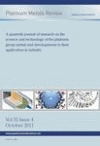-
oa Novel Method of Electrical Storage
Transfer of Hydrogen Between Electrodes of Palladium Alloys
- Source: Platinum Metals Review, Volume 7, Issue 3, Jul 1963, p. 88 - 89
-
- 01 Jan 1963
Abstract
Different pairs of palladium alloys can form a series of secondary cells that depend for their operation, both during charging and discharging, solely on the transfer of hydrogen from one electrode to the other. Cells may be prepared with a low internal resistance and future studies of a wider range of palladium alloys are likely to extend the range of working voltages available.
© Johnson Matthey


